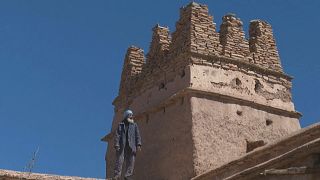Libya
This ancient city has stood proud since the Roman era.
But now graffiti covers the walls of Sabratha, a UNESCO World Heritage Site.
In 2016 UNESCO added the site to the list of World Heritage in Danger.
Sabratha started out as a Phoenician trading post according to UNESCO, a part of the Numidian Kingdom of Massinissa before the Romans rebuilt it in the second and third centuries.
Now apart from the odd school visit the city is neglected and it has become a target for vandalism.
Tour guide Adel Mahmoud says young visitors to this fragile site are often unattended and they don't know how to behave around the ancient remains.
“We appeal to the people, our mothers, our young ones, our children, our elders, our youth, and the schools that come here. These schools are supposed to bring a guide with them so that they can watch this ancient city (in an organized manner),” he says.
Libya's archaeological sites have been damaged by insecurity and looting during the chaos and fighting that followed the 2011 overthrow of Muammar Gaddafi's regime, with rival factions competing for control of the country.
Mahmoud is appealing to the country's Antiquities Department to assist the tour guides in preserving the site.
“We ask the Antiquities Department and the Government, especially the government and the prime minister, to pay attention to these antiquities, because they have been here for thousands of years, especially since here in Sabratha, this city is built of sandstone that are easily damaged,” he says.
Mahmoud has worked around this ancient city for 34 years.
UNESCO included Sabratha and four other Libyan sites on the List of World Heritage in Danger in July 2016 because of the damage caused to it and the many threats surrounding it.
UNESCO indicated that Libya still suffers from instability, and it is calling for the protection of antiquities in the country.
Mahmoud says structures around the city are failing and areas which become exposed to the weather are crumbling.
“The baths are inside the city and half of them have fallen due to winters, given all that we ask them (Antiquities Department and government) for support, as the labour force is here, but it needs support. Financial and moral support,” he says.
The Punic temples surrounding the market square, the judicial court, and the municipal council were rebuilt in the fourth century AD.
The ancient city is also famous for its huge Roman theatre, but with no foreign tourists, only Libyan families on weekends visit the site.











01:17
UNESCO inscribes 26 new sites on World Heritage list
02:19
Abuja residents celebrate Igbo festival in grand style
00:51
Marrakech national festival: honoring the legacy of popular arts
01:24
French parliament votes to return sacred "talking drum" to Ivory Coast
02:19
Morocco sees surge in Chinese tourists
02:20
Ancient DNA reveals genetic link between early Egypt and Mesopotamia